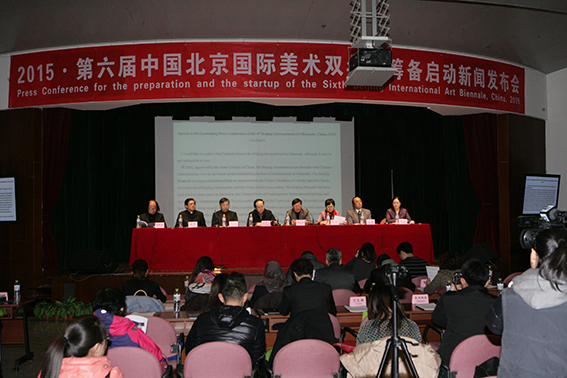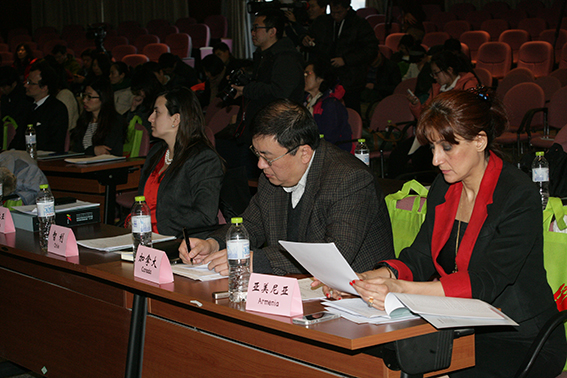
Photo by Meng Xiangning, taken at the press conference for the preparation and launching of the 6th Beijing International Art Biennale
On Jan. 20, 2014, the press conference for the preparation and launching of the 6th Beijing International Art Biennale, China (hereinafter referred to as Beijing Biennale), with the theme of “Memory and Dream”, was held at the Lecture Hall of China Federation of Literary and Art Circles (CFLAC). Representatives of the organizers attended the press conference, including Zuo Zhongyi, Vice Chairman of CFLAC, Liu Dawei, President of China Artists Association (CAA), Wu Changjiang, Standing Vice President of CAA, Guan Yu, Director of Beijing Municipal Bureau of Culture, Xu Li, Secretary General of CAA, and Tao Qin, Deputy Secretary General of CAA. Honored guests present included Wang Yong, researcher at Chinese National Academy of Fine Arts, and Zhang Xiaoling, Vice President of China National Academy of Painting. Diplomatic corps to China present were as follows: Mr. Guillermo E. Devoto, Minister at the Embassy of Argentina in Beijing, Mr. Amadou Fall, Cultural Counselor at the Embassy of the Republic of Senegal, as well as press and cultural diplomats at foreign embassies in China, including Armenia, Canada, Columbia, Ecuador, France, Indonesia, Italy, Serbia, Sri Lanka, the Philippines, Russia, Venezuela, Vietnam, etc. More than 60 news media attended the press conference, including the Xinhua News Agency, China Central Television, STAR TV (Hong Kong), People’s Daily, Guangming Daily, Macao Daily News, Sina.com, Sohu.com, etc. The press conference was presided over by Tao Qin, Deputy Secretary General of China Artists Association.
Beijing Biennale’s Executive Director Zuo Zhongyi made an address first of all. He explained the theme, and stressed the significance of “China Dream” for the current artistic creation and the Beijing Biennale as an international art platform.

Photos are taken by Meng Xiangning. Diplomatic missions of foreign embassies in China at the press conference for the preparation and launching of the 6th Beijing International Art Biennale
He said that the Beijing International Art Biennale has been successfully held for five times, gaining extensive attention and favorable comments. The theme for the 6th Beijing Biennale is “Memory and Dream”. Memory and dream are extremely precious, not matter for individuals, collectives, countries, or nationalities. Without memory, human civilization cannot continue; without dream, it cannot move ahead. Everybody has their own dreams. And artists are excellent dream-seekers, because art activities, being pure mental behaviors, are destined to cut across memories, reality and dreams. Dreams are human being’s beautiful ideals, hopes of alleviating disasters, longings for pursuing happiness, and goals of untiringly struggle. When artists use arts to express dreams, they change them into a sublime realm and a spiritual dimension full of creative power and appeal. The great renewal of the Chinese nation has been a long-cherished dream of the Chinese nation since modern times, as well as the liveliest social practice in contemporary China. Depicting and promoting China Dream is a due historical responsibility of Chinese artists. Meanwhile, the China Dream demonstrates the spirits of openness and inclusiveness. It not only implies the harmony and happiness of Chinese people, but also raises awareness about human beings sharing a community of common destiny, advocates the world’s sharing of China’s achievements and the seeking of a great vision. People, including artists, in different countries share the common goal of pursuing beautiful homes and harmonious life. The spirit of China Dream provides a vast space for artists to exploit their talents. It is contemporary artists’ sublime responsibility to looking forward to a bright future and display human beings’ dreams. Artists from different countries are expected to give full play to their personal creation and image expression with good ideals and romantic themes on this platform.
Beijing Biennale’s Executive Director Liu Dawei introduced Beijing Biennale’s development history over the past decade since its establishment to the media and guests present, starting from the exhibition in 2003.
He said that, approved by the State Council of China in 2003, the Beijing International Art Biennale with Chinese characteristics was set up based on the established practices of international art biennales. Held in Beijing, China’s political and cultural center, the Beijing Biennale enjoys unique geographical advantages and cultural strength, which leaves it better positioned to highlight the strategic significance of China’s cultural development than being held in other places. In terms of the cultural subject and the positioning of aesthetics, distinctive contemporary Chinese features have taken shape since the very beginning of the Beijing Biennale. The Biennale demonstrates the magnificence of the reform and opening-up of China and China’s willingness to assimilate the essence of the contemporary culture in eastern and western countries, and it is committed to turning Beijing into a center for international exchanges of the art of contemporary paintings and sculptures. The Outline of the Eleventh Five-year Plan for National Culture Development unveiled in September 2006 listed the Beijing International Art Biennale as one of the “highlighted well-known cultural events”. The Beijing Biennale’s idea of building a harmonious world and its proposal of respecting the cultural diversity and facilitating dialogues between the eastern and western cultures on the basis of equality are well received by international artists. It is praised as “a bridge between the East and West, and a bond connecting tradition and modernity”. It also provides a platform for equal dialogues with the international community, and establishes a set of modes of exhibition operation following both international conventions and China’s national conditions. In a sense, the Beijing Biennale rewrites the history of contemporary Chinese art being subordinate and passive worldwide.
Journalists from People’s Daily, Beijing TV Station, and Xinhuanet.com asked questions about the core curatorial philosophy of the 6th Beijing Biennale, the selection criteria of work’s art style, the detailed planning for the joint preparation by the organizers, and the new features that might appear in the 6th Beijing Biennale, etc. Executive Director Wu Changjiang, Guan Yu, Wang Yong and some other guests answered journalists’ questions respectively.
When answering questions of journalists, Wu Changjiang said that the peak period (heyday) of biennales worldwide was in the 1990s.China also began to hold various kinds of biennales as from that period. To date, organizers have become quite rational in holding a biennale after the excessive fever faded, through accumulation and natural elimination. Take the Beijing Biennale as a special example. It has not copied any foreign biennale models since its establishment. Instead, it has been sticking to its own academic concepts, which is just one of the reasons for artists worldwide to approach and support the Beijing Biennale with great enthusiasm. Works displayed in the Beijing Biennale cover a wide range of themes, providing an open platform for artists. No matter he or she is “academic”, “liberal”, or an “overseas returnee”, they are welcome to submit their works as long as their academic concepts tally with the exhibition’s academic direction, and their works can interpret the exhibition’s theme. Of course, we especially welcome young artists to submit their works. While collecting works extensively, we also give full play to the curatorial team’s advantage of collective curation, and jointly select several specially-invited artists to create theme pieces specially for the exhibition, so as to supplement the free-lance works and ensure that domestic works will present their best ones with optimum effect to conduct wonderful visual communication with foreign art works.
When answering questions of journalists, Guan Yu said that he attended the opening ceremony for the 5th Beijing Biennale. He enjoyed the atmosphere of artists worldwide getting together very much. And it’s quite interesting to leaf through an album of paintings of the Beijing Biennale. As the only official domestic biennale named after Beijing, the Beijing Biennale makes itself unique with its distinct academic propositions in Chinese and the world’s art field since its birth. Being the country’s cultural center, Beijing is obliged to build state-level or even world-class branding projects in every area of culture and art, so as to keep its leadership in advanced culture. The Beijing Biennale is exactly the most important project to drive the development of Beijing’s fine arts, bringing many benefits for Beijing: firstly, Beijing citizens could appreciate so many excellent art works worldwide at home; secondly, considering that creative cultural industry is a future developing tendency, and art can inspire creativity, so we cherish this project and the cooperation with other organizers greatly; thus, no matter it is project fund, exhibition spaces, or atmosphere building, we all offer strong support and coordination, and try to make the Beijing Biennale a new symbol of Beijing and play a bigger role in Beijing’s contemporary cultural development, through joint efforts with CFLAC and China Artists Association.
When answering questions of journalists, Wang Yong said that as painting, sculpture and other traditional artistic forms get into the contemporary cultural context, they keep their sustainable development vitality and the huge creation space. Between traditional and new art forms, there is no impassable gulf, nor binary opposition that is black or white. A new art form evolves from traditional ones. To some degree, it can be said that device is an extension of sculpture, image is a variation of painting, and digital art is a synthetic art in the Internet age. Ultimately, art form serves the expression of artists’ thoughts and emotions. No matter traditional or new art form, as long as it perfectly expresses contemporary artists’ deep and sincere feelings, it can be an excellent contemporary art work. As long as it meets the requirements of the 6th Beijing Biennale’s theme-“Memory and Dream”, it can be selected as an exhibition work. Certainly, we are relatively more familiar with the evaluation criteria for traditional art forms such as painting and sculpture, and they are easier to be accepted by the public following their aesthetic habits, but lack professional and systematic evaluation criteria. Even western contemporary art critics admit that evaluation criteria are hard to handle, whose public acceptance is not quite universal.
The trailer for the 6th Beijing Biennale broadcast at the press conference vividly reproduces the amazing chapters of the previous Beijing Biennales for domestic and foreign guests.
A system of collective exhibition curation is adopted by the Beijing Biennale and the planning committee is composed of art experts and scholars from home and abroad. The Beijing Biennale has been always taking the concept of building a harmonious world as the basis of the biennale planning, and it aims to promote the world harmony, social progress and human happiness through this exhibition of contemporary arts. With the theme “Innovation: Contemporary and Regional”, the first Beijing Biennale advocated the spirit of cultural innovation that accommodated contemporaneity and regionalism. The theme of the second Beijing Biennale was “Humanistic Concerns of the Contemporary Art” which expressed the contemporary art’s focus on the real life in society and the general public. “Colors and Olympics”, the theme of the third Beijing Biennale, revealed and interpreted the Olympic spirit. “Environment Concern and Human Existence”, the theme of the fourth Beijing Biennale, revealed the attention of Chinese and foreign artists to ecological problems and their position and responsibility. The theme of the fifth Beijing Biennale---“Future and Reality” combined the spiritual pursuit of the future with the humanistic care in reality with a view to building an art world in which we could go beyond reality and head to the future. The Beijing Biennale’s idea of building a harmonious world and its proposal of respecting the cultural diversity and facilitating dialogues between the eastern and western cultures on the basis of equality are well received by international artists.
The previous five Beijing Biennales witnessed an increasing number of countries participating in the exhibition, from 45 countries and regions in 2003 to 87 ones in 2012. Through years of development, the Beijing Biennale has almost 100 participating countries, over 3,000 artists, more than 3,000 exhibited works, tens of thousands of letters from home and abroad, and over a million visitors in total. Party and state leaders including Liu Yunshan, Jia Qinglin, Li Changchun, Chen Zhili, Liu Yandong, Liu Qi and Sun Jiazheng had paid special visits to the Biennales. International distinguished guests, heads of diplomatic missions, cultural officials and artists also attended the opening ceremonies, or saw the exhibitions, including the Queen of Norway, UNESCO officials, Austrian Federal Minister of Education, Art and Culture, curator of the Vatican Museum, et al. During each of the previous five Beijing Biennales, large international academic seminars were held. With the idea of build a harmonious world through exhibitions of contemporary arts, as well as the proposition of respecting the world’s cultural diversity and equal dialogues between Eastern and Western cultures, the Beijing Biennale receives welcome and support from more and more artists around the world, draws attention from important international personages, and has been reported enthusiastically by more than 100 news media in the world.
Ms. Theobald, Chief of the Section for Non-Governmental Organizations of UNESCO, attended the third Beijing Biennale and sent us a mail saying: The Beijing Biennale presented the Chinese contemporary art to her with amazingly diversified and first-class works. Besides, it provides a broad platform for international exchanges of art. The combination of UNESCO and the Beijing Biennale is the best interpretation of the role of visual arts in promoting the cultural diversity, mutual understanding and dialogues between different cultures.
“Picturesque landscape”, one of the exhibited works at the 3rd Beijing Biennale, was temporarily transferred to the VIP Hall of the National Centre for the Performing Arts, which added an art scene to the 120th plenary session of the International Olympic Committee (IOC) chaired by Hu Jintao, former President of the People’s Republic of China, and Jacques Rogge, President of the IOC. Reuters said that “this biennale with the theme of ‘Colors and Olympics’ has attracted the worldwide attention thanks to its large scale and diversified exhibited works” after it covered the news at the 3rd Beijing Biennale.
The U.S.-based Taiwanese art critic Chien Hui Kao wrote in an article that “exhibitions of contemporary art held at different places not only serve as platforms for intercontinental cultural dialogues, but also is a relay race for host countries to interpret their cultures to the rest of the world. The protection of cultural subjects by the Beijing Biennale reflects its determination to guard against the colonization of art and culture. The Beijing Biennale is an indicator with a historical meaning for Beijing and China.”
An editorial of the People’s Daily with the title of “Painting Aspiration and Homeland Dream” wrote that “Ranging from the Western-style expression to the Eastern-style statement, as an international exhibition, the Beijing Biennale is so different from other art exhibitions. In this cross-cultural communication, the audience will cross the geographical and cultural boundaries to take a bird’s-eye view of the landscape of society and souls. The common ideals of human beings can be highlighted through this biennale --- the fight against the homogenization of lives caused by impacts of the globalization, desire for beauty, intimation with the nature and the protection of homes.... A Beijing Biennale with inclusiveness, diversity and humanistic care has been presented to us.”
The new website and the WeChat account of the Beijing Biennale were officially launched at the press conference. The organizer will release and update relevant information about the preparation of the 6th Beijing Biennale in forms of texts and pictures in due course which is the supplement to the official website of the Beijing Biennale. Catalogues of the works in the previous five Beijing Biennales have been converted to e-books by artron.net and posted on the official website of the Beijing Biennale to facilitate the online search.

The QR code of the WeChat account of the Beijing International Art Biennale, China
In the media interview after the press conference, the attending representatives of various foreign embassies in China expressed their expectation for the 6th Beijing Biennale and their willingness to recommend artists in their own countries to attend it.
The Cultural Attaché of the Embassy of Italy in Beijing said that “It’s a very interesting biennale and we think it is important to China. We expect that many Italian artists will be interested in attending this biennale. Many Italian artists attended the Beijing Biennale before, and I believe more painters and sculptors will be there. The theme of the 6th Beijing Biennale is ‘Memory and Dream’, and I hope to see more ties between Italy and China. As we have a long history like China, the memory and looking forward to the future are also very important to us. This theme, I believe, is very good for the communication between artists and between us. ”
Mr. Guillermo E. Devoto, Minister of the Embassy of the Argentina in China, said that “we will publicize the biennale in our media to attract more Argentine artists to attend the Beijing Biennale.”
The warm responses from representatives of various foreign embassies have laid a solid foundation for the promotion in foreign embassies to be carried out by sponsors.
This press conference also indicates the official start of soliciting contributions to the 6th Beijing Biennale and the deadline is December 2014. Regulations, related forms and texts of the Biennale can be downloaded freely from the official website of the Beijing Biennale. Regulations of the Biennale will also be published by the Organizing Committee of the Beijing Biennale in professional newspapers and periodicals such as Art Magazine (‘美术’ in Chinese), Art Observation and China Arts Weekly, etc.. Interested contributors can go to the office of the Beijing Biennale at the China Artists Association to ask for the free brochure of the Biennale.
The press conference called upon all sectors of society to expect a brand-new international art event in the autumn of 2015. The 6th Beijing Biennale co-sponsored by the China Federation of Literary and Art Circles, Beijing Municipal Government and the China Artists Association will present the ideals and concerns shared by artists from various countries to the audience in diversified and inclusive forms of art. The press conference called on different sectors to publicize the Beijing Biennale so that more people can get the information of the 6th Beijing Biennale in a timely manner, and to make joint efforts so that the art dreams of artists from all over the world can be realized in Beijing in 2015!
